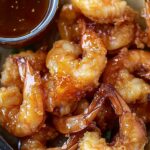Bulgogi Kimchi Fried Rice is an irresistible fusion of flavors combining the spicy kick of kimchi, the umami of gochujang, and the tender, caramelized goodness of beef bulgogi. This Korean-inspired dish is vibrant, hearty, and perfect for anyone who loves fried rice with a twist. It’s a quick, easy, and flavorful meal that’s sure to become a favorite.
Full Recipe:
Ingredients
For the Bulgogi Beef:
- 1 pound flank steak, thinly sliced
- 3 tablespoons soy sauce
- 2 tablespoons brown sugar
- 2 tablespoons pear puree (or grated Asian pear)
- 1 tablespoon sesame oil
- 2 cloves garlic, minced
- 1 teaspoon grated ginger
- 1 teaspoon chili powder
- ½ teaspoon red pepper flakes
- ½ teaspoon black pepper
- 1 tablespoon olive oil
- 1 teaspoon rice vinegar
For the Kimchi Fried Rice:
- 2 tablespoons butter
- 2 cloves garlic, minced
- 1 tablespoon gochujang (Korean chili paste)
- 4 cups day-old jasmine rice
- 1 cup frozen carrots and peas
- 1 cup kimchi, chopped
- 2 tablespoons kimchi juice
- ½ teaspoon red pepper flakes
- ½ teaspoon chili powder
- 2 tablespoons soy sauce
- Salt and black pepper to taste
- 1 tablespoon sesame oil
Toppings (Optional):
- Sesame seeds
- Fried egg
- Chopped seaweed
Directions
- Prepare the Bulgogi Beef:
- In a bowl, mix soy sauce, brown sugar, pear puree, sesame oil, garlic, ginger, chili powder, red pepper flakes, black pepper, olive oil, and rice vinegar. Add the sliced flank steak and coat evenly. Let marinate for at least 30 minutes or overnight for best results.
- Heat a pan over high heat. Cook the marinated beef in batches to avoid overcrowding. Allow it to brown and caramelize. Remove from the pan once cooked and set aside.
- Cook the Kimchi Fried Rice:
- In the same pan, melt butter over medium heat. Add minced garlic and gochujang, sautéing until fragrant.
- Add the day-old jasmine rice, breaking up clumps. Stir in the frozen carrots, peas, chopped kimchi, and kimchi juice.
- Season with red pepper flakes, chili powder, soy sauce, black pepper, and salt. Stir well and fry the rice for 2 to 3 minutes.
- Drizzle sesame oil over the rice and mix.
- Assemble the Dish:
- Serve the fried rice on a plate, topped with the bulgogi beef.
- Garnish with sesame seeds, a fried egg, and chopped seaweed, if desired.
Nutrients (Approximate per Serving)
- Calories: 550-600
- Protein: 25g
- Carbohydrates: 70g
- Fat: 20g
- Fiber: 5g
- Sodium: 1200mg
The Cultural Significance of Bulgogi and Kimchi
Bulgogi, which translates to “fire meat” in Korean, is one of Korea’s most iconic dishes. Traditionally made with thinly sliced beef marinated in a blend of soy sauce, sugar, sesame oil, garlic, and other seasonings, bulgogi represents the perfect balance of sweet, savory, and umami flavors. Its caramelized edges and juicy texture make it irresistible, especially when paired with complementary ingredients like rice and vegetables.
Kimchi, on the other hand, is a fermented vegetable dish, typically made with napa cabbage and radishes. It is seasoned with chili powder, garlic, ginger, and fish sauce, creating a spicy, tangy flavor that has been a staple in Korean cuisine for centuries. Kimchi is not just a side dish—it’s a symbol of Korean heritage and culture, often enjoyed as part of almost every meal.
By combining these two quintessential elements—bulgogi and kimchi—Bulgogi Kimchi Fried Rice becomes a fusion of tradition and creativity, embodying the heart and soul of Korean culinary art.
The Flavors That Define Bulgogi Kimchi Fried Rice
What makes Bulgogi Kimchi Fried Rice stand out is its intricate layering of flavors. The dish starts with tender slices of beef bulgogi, marinated to perfection with a blend of soy sauce, pear puree, garlic, and sesame oil. The marinade not only enhances the flavor but also tenderizes the beef, allowing it to cook quickly while achieving a caramelized exterior.
The fried rice base brings in the bold and tangy kick of kimchi, paired with the sweet, spicy, and umami notes of gochujang (Korean chili paste). The addition of butter gives the dish a rich, velvety texture, while vegetables like carrots and peas add pops of color and subtle sweetness. A final drizzle of sesame oil ties everything together, infusing the dish with a nutty aroma that is quintessentially Korean.
Why This Dish is Perfect for Any Occasion
Bulgogi Kimchi Fried Rice is versatile and can suit various occasions. Whether you’re looking for a comforting weeknight meal or an impressive dish to serve at a gathering, this recipe fits the bill. Its vibrant colors and bold flavors make it visually appealing, while its balance of protein, carbohydrates, and vegetables ensures it is both satisfying and nutritious.
This dish is also highly adaptable. You can customize the level of spice by adjusting the amount of gochujang or chili flakes, and you can add your favorite vegetables for a personal touch. For those who prefer a plant-based option, swapping out the beef for tofu or mushrooms creates a delightful vegetarian version.
The Art of Cooking Bulgogi Kimchi Fried Rice
Although this dish is straightforward, achieving the perfect balance of flavors and textures requires some attention to detail. Using day-old rice is key, as it has a firmer texture that holds up well when stir-fried. The beef must be cooked in small batches to ensure even caramelization, and the kimchi should be well-fermented for a deeper, more robust flavor.
The toppings play an essential role in elevating the dish. A fried egg with a runny yolk adds creaminess, while sesame seeds and seaweed provide crunch and a hint of umami. These garnishes not only enhance the flavor but also create a stunning presentation that is sure to impress.
Health Benefits of Bulgogi Kimchi Fried Rice
Beyond its incredible taste, Bulgogi Kimchi Fried Rice offers several health benefits. Kimchi is rich in probiotics, which promote gut health and support the immune system. It is also packed with vitamins A, B, and C, as well as antioxidants that help reduce inflammation.
The bulgogi beef provides a high-quality source of protein, essential for muscle repair and growth. The vegetables in the dish contribute dietary fiber, vitamins, and minerals, making it a well-rounded meal. By using sesame oil and olive oil in moderation, this dish maintains a balance of healthy fats that are beneficial for heart health.
Tips for Success When Making Bulgogi Kimchi Fried Rice
- Use High-Quality Ingredients: The flavor of this dish depends heavily on the quality of its components. Opt for fresh, well-marinated beef, authentic Korean kimchi, and premium gochujang for the best results.
- Prepare in Advance: Marinate the beef and chop all your vegetables before you start cooking. Having everything ready to go ensures a smooth cooking process and prevents overcooking.
- Cook in Batches: To achieve the perfect caramelization on the beef, avoid overcrowding the pan. Cook the beef in small batches over high heat for the best texture and flavor.
- Adjust to Taste: Feel free to tweak the spice level or sweetness according to your preferences. You can also experiment with different vegetables or protein options to make the dish your own.
- Presentation Matters: Garnish generously with sesame seeds, seaweed, and a fried egg to create a restaurant-quality dish that looks as good as it tastes.
Conclusion
Bulgogi Kimchi Fried Rice is a celebration of Korean flavors and culinary traditions. Its perfect harmony of spicy, savory, and slightly sweet notes creates an unforgettable taste experience that appeals to food lovers everywhere. This dish is not just a meal—it’s a sensory journey that combines the comfort of fried rice with the boldness of kimchi and the indulgence of bulgogi beef.
Whether you’re making it for yourself or sharing it with loved ones, Bulgogi Kimchi Fried Rice is a surefire way to impress and delight. Its versatility, ease of preparation, and incredible flavor make it a recipe worth adding to your repertoire. Try it today and experience the magic of Korean-inspired cooking in your own kitchen.






